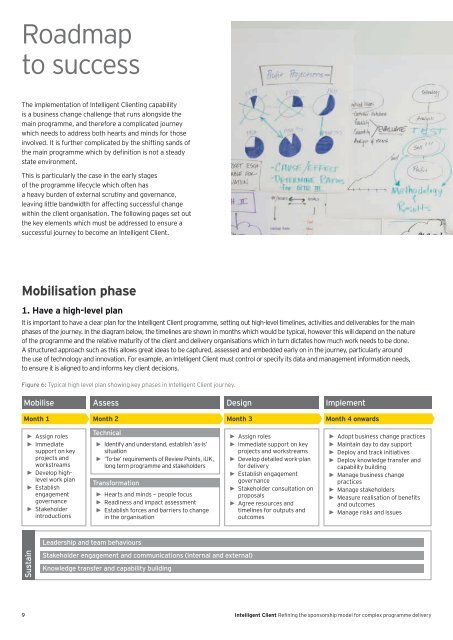EY-Intelligent-Client-strategic-sponsorship
EY-Intelligent-Client-strategic-sponsorship
EY-Intelligent-Client-strategic-sponsorship
Create successful ePaper yourself
Turn your PDF publications into a flip-book with our unique Google optimized e-Paper software.
Roadmap<br />
to success<br />
The implementation of <strong>Intelligent</strong> <strong>Client</strong>ing capability<br />
is a business change challenge that runs alongside the<br />
main programme, and therefore a complicated journey<br />
which needs to address both hearts and minds for those<br />
involved. It is further complicated by the shifting sands of<br />
the main programme which by definition is not a steady<br />
state environment.<br />
This is particularly the case in the early stages<br />
of the programme lifecycle which often has<br />
a heavy burden of external scrutiny and governance,<br />
leaving little bandwidth for affecting successful change<br />
within the client organisation. The following pages set out<br />
the key elements which must be addressed to ensure a<br />
successful journey to become an <strong>Intelligent</strong> <strong>Client</strong>.<br />
Mobilisation phase<br />
1. Have a high-level plan<br />
It is important to have a clear plan for the <strong>Intelligent</strong> <strong>Client</strong> programme, setting out high-level timelines, activities and deliverables for the main<br />
phases of the journey. In the diagram below, the timelines are shown in months which would be typical, however this will depend on the nature<br />
of the programme and the relative maturity of the client and delivery organisations which in turn dictates how much work needs to be done.<br />
A structured approach such as this allows great ideas to be captured, assessed and embedded early on in the journey, particularly around<br />
the use of technology and innovation. For example, an <strong>Intelligent</strong> <strong>Client</strong> must control or specify its data and management information needs,<br />
to ensure it is aligned to and informs key client decisions.<br />
Figure 6: Typical high level plan showing key phases in <strong>Intelligent</strong> <strong>Client</strong> journey.<br />
Mobilise Assess<br />
Design Implement<br />
Month 1 Month 2 Month 3 Month 4 onwards<br />
►►<br />
Assign roles<br />
►►<br />
Immediate<br />
support on key<br />
projects and<br />
workstreams<br />
►►<br />
Develop highlevel<br />
work plan<br />
►►<br />
Establish<br />
engagement<br />
governance<br />
►►<br />
Stakeholder<br />
introductions<br />
Technical<br />
►►<br />
Identify and understand, establish ‘as-is’<br />
situation<br />
► ► ‘To-be’ requirements of Review Points, iUK,<br />
long term programme and stakeholders<br />
Transformation<br />
►►<br />
Hearts and minds — people focus<br />
►►<br />
Readiness and impact assessment<br />
►►<br />
Establish forces and barriers to change<br />
in the organisation<br />
►►<br />
Assign roles<br />
►►<br />
Immediate support on key<br />
projects and workstreams<br />
►►<br />
Develop detailed work-plan<br />
for delivery<br />
►►<br />
Establish engagement<br />
governance<br />
►►<br />
Stakeholder consultation on<br />
proposals<br />
►►<br />
Agree resources and<br />
timelines for outputs and<br />
outcomes<br />
►►<br />
Adopt business change practices<br />
►►<br />
Maintain day to day support<br />
►►<br />
Deploy and track initiatives<br />
►►<br />
Deploy knowledge transfer and<br />
capability building<br />
►►<br />
Manage business change<br />
practices<br />
►►<br />
Manage stakeholders<br />
►►<br />
Measure realisation of benefits<br />
and outcomes<br />
►►<br />
Manage risks and issues<br />
Leadership and team behaviours<br />
Sustain<br />
Stakeholder engagement and communications (internal and external)<br />
Knowledge transfer and capability building<br />
9 <strong>Intelligent</strong> <strong>Client</strong> Refining the <strong>sponsorship</strong> model for complex programme delivery



